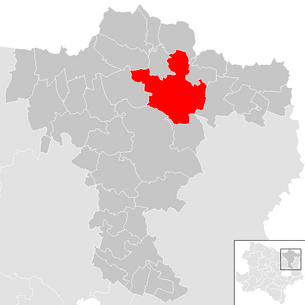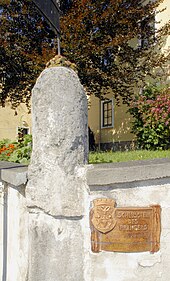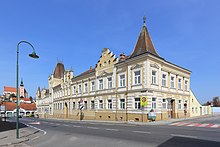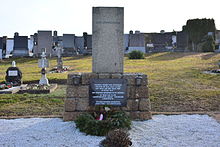Poysdorf
|
Borough Poysdorf
|
||
|---|---|---|
| coat of arms | Austria map | |
|
|
||
| Basic data | ||
| Country: | Austria | |
| State : | Lower Austria | |
| Political District : | Mistelbach | |
| License plate : | MI | |
| Surface: | 97.28 km² | |
| Coordinates : | 48 ° 40 ′ N , 16 ° 38 ′ E | |
| Height : | 225 m above sea level A. | |
| Residents : | 5,483 (January 1, 2020) | |
| Population density : | 56 inhabitants per km² | |
| Postal code : | 2170 | |
| Area code : | 0 25 52 | |
| Community code : | 3 16 44 | |
| NUTS region | AT125 | |
| UN / LOCODE | AT POY | |
| Address of the municipal administration: |
Josefsplatz 1 2170 Poysdorf |
|
| Website: | ||
| politics | ||
| Mayor : | Thomas Grießl ( ÖVP ) | |
|
Municipal Council : ( 2020 ) (29 members) |
||
| Location of Poysdorf in the Mistelbach district | ||
 View from the tower of the parish church |
||
| Source: Municipal data from Statistics Austria | ||
Poysdorf is a town with 5483 inhabitants (as of January 1, 2020) in the Mistelbach district in northern Lower Austria .
geography
Poysdorf is located in the northern Weinviertel on Brünner Straße , in the Weinviertel hill country and in the valley of the Poybach , which flows into the Zaya between Rannersdorf an der Zaya and Hauskirchen .
The Jakobsweg Weinviertel , which has been signposted since 2010 and which leads from the Holy Mountain near Nikolsburg Svatý kopeček u Mikulova in the South Moravian town of Nikolsburg im Okres Břeclav to Krems an der Donau and is part of the Via Francigena and the Via Slavica , leads through the municipality .
Community structure
The municipal area comprises the following 10 localities (population in brackets as of January 1, 2020):
- Altruppersdorf (342)
- Erdberg (247)
- Follim (166)
- Ketzelsdorf (191)
- Kleinhadersdorf (431)
- Poysbrunn (362)
- Poysdorf (2615)
- Walterskirchen (438) including the new building
- Wetzelsdorf (505)
- Wilhelmsdorf (186)
The community consists of the cadastral communities Altruppersdorf, Erdberg , Föllim , Höbertsgrub, Ketzelsdorf, Kleinhadersdorf , Passauerhof, Poysbrunn , Poysdorf, Walterskirchen, Wetzelsdorf and Wilhelmsdorf .
Neighboring communities
The following communities border Poysdorf:
| Neudorf in the Weinviertel , Falkenstein | Drasenhofen | Herrnbaumgarten |
| Staatz |

|
Great Krut |
| Mistelbach | Wilfersdorf |
climate
Poysdorf is located in the northeastern Weinviertel . There is a central European transitional climate with continental influence from the east and oceanic influence from the west. The average temperature in the normal climate period 1981–2010 is around 10 ° C and ranges from −1 ° C in January to 20 ° C in July. Every year there are 91 frost days , 27 ice days , 65 summer days and 16 hot days . The mean daily maximum temperatures range from 2 ° C in January to 27 ° C in July, the mean minimum temperatures from −4 ° C in January to 14 ° C in July. Due to global warming, the maximum daily temperatures in particular rise in the summer months. With an annual rainfall of only 500 to 600 mm, Poysdorf is one of the driest cities in Austria. Most precipitation falls in the months May to September. There are 91 days with at least 1 mm of rain and 15 days with at least 10 mm of rain. An annual average of 20 thunderstorms are recorded, almost all of which fall during the summer half-year. Hail occurs on average once a year. The Weinviertel is characterized by cloudy days in winter and sunny days in summer. 72% of the annual sunshine falls from April to September. Due to the low altitude, there is only 41 cm of fresh snow per year, which falls mainly from December to February and usually only remains for a short time. The mean wind speed is 10 km / h. There are hardly any differences in the monthly mean. It reaches its maximum in April with 12 km / h and its minimum in August and September with 9 km / h. In the daytime, however, there are clear differences between day and night, especially in the summer half-year: the gusts of wind are much stronger during the day than at night. On the one hand, this is due to thermal detachments that occur exclusively during the day and, on the other hand, to the absence of inversions that prevent stronger winds from reaching through from higher air layers.
|
Climate diagram for Poysdorf (198 m)
Source: ZAMG 1981–2010
|
||||||||||||||||||||||||||||||||||||||||||||||||||||||||||||||||||||||||||||||||||||||||||||||||||||||||||||||||||||||||
history
Beginnings to the Middle Ages
Poysdorf was founded on a very historical ground. The first farmers settled here 7000 years ago. This is proven by numerous finds from the Neolithic and Bronze Age .
The Angerdorf Poysdorf was first mentioned in 1194/1196 in the Klosterneuburg Saalbuch. It reports that Rapoto von Liechtenstein handed over two fiefdoms to “Poistorf” when his daughter was admitted to the women's monastery in Klosterneuburg .
The place name is derived from the Slavic personal name * Bojь (compare the current Slavic name Bojan). The name “Poybach” was derived from this.
Since Poysdorf was in a border region, all sorts of warlike entanglements and hostile incursions hit the place. Whether this was triggered by the Hungarians during Duke Heinrich II. Jasomirgott , whether Duke Friedrich II, the warrior , tried to keep the Mongols from the border of Lower Austria or whether the Hungarians wanted to get their lost border fortresses back in Burgenland , Poysdorf was at the heart of the action (1176, 1226, 1241/42). Again and again the kings of Bohemia tried to bring the area under their rule.
Modern times
The " Eisenhuthaus " was built in the 16th century - today it is probably the oldest preserved building in the wine town. On May 4, 1582, Emperor Rudolf II raised the village of Poysdorf, which at that time had 200 "built" houses and farms and around 1500 inhabitants, to the market , as it had achieved a certain wealth and reputation by silvering and selling its wine . A pillory was erected by the Poysdorfers as an outward sign of the privilege of “ market rights ” .
Over time, several market days were approved and other privileges granted. In 1667, the market in Poysdorf chose a representation for its coat of arms and seal , which clarified the importance of wine for the market: the "wine carriers" or "scouts".
In 1631 a whole regiment of the Wallenstein army was quartered in the village.
In 1639 a fire burned 170 of the 250 houses.

During the final phase of the Thirty Years' War , on Palm Sunday 1645, a vanguard who came Sweden under General Lennart Torstensson of Mistelbach over Kleinhadersdorf to Poysdorf and built the new, only 1640 consecrated church into a fortress from. In the western part of the church they hired their horses. These rows of seats are still called "riding schools" today. In order to protect Poysdorf from looting , the Poysdorfers delivered 1000 buckets of wine , grain , oats , food , wagons , horses and cattle. In return, the market received the Salva Guardia letter of protection , which spared the residents of the worst offenses. It was not until August 1646 that the immediate Swedish threat to Vienna and Lower Austria could be averted. But during the winter of 1645 the plague broke out. A total of 5,000 people, both Poysdorfers and refugees, are said to have died from the disease .
The civil hospital (1657) and the Barbara chapel (1663) , the new shooting range (1672) and the Capuchin monastery at the Wienertor (1673) owe their existence to the reconstruction in Poysdorf .
On September 7th, 1848, the repeal of the manor was decided by the Reichstag , thus ending the centuries of subservience of the Austrian peasants. However, it also brought certain disadvantages for the farmers, as from now on no one would lend them seeds in the event of a bad harvest .
Due to the end of the manorial rule, which until then had been the public administration and jurisdiction , a new order was now necessary. Therefore, on March 17, 1849, the provisional Reichsgemeindegesetz was promulgated, in which, in addition to the cadastral communities , local communities were also provided as political organs. One or more cadastral parishes should form a local parish.
On the basis of this provisional imperial community law, the newly constituted local community Poysdorf was formed, which in 1850 had 2,327 inhabitants and 382 houses on an area of 11.85 km².
On July 10, 1850, the first election of a mayor by the free community took place.
In 1849, the market in Poysdorf was to become the seat of a district administration , Laa , Mistelbach, Feldsberg and Zistersdorf a district court . In 1852, BH immediately moved to the new town hall . However, in the same year, the state dissolved the bras and transferred the administration to the district courts. The new seat for the office was from now on Mistelbach.
In 1866, in the course of the German War, Austro-Hungarian troops marched in and were quartered here. After the defeat in the Battle of Königgrätz on July 3, the first 70 Uhlans marched in on July 16, 1866 . On July 17, 1866, 6,000 Prussian Uhlans were camped in Poysdorf. After the armistice between Austria and Prussia on July 22, 1866, the Poysdorfers were compensated with 200 guilders for the poor. The foreign soldiers brought typhus and dysentery with them, which fueled the epidemic spread of cholera . 136 Prussian soldiers and 180 residents of the market were killed by cholera. The dead Prussians were buried in a mass grave on Brünner Strasse. French soldiers who died in 1805 and 1809 were buried in the immediate vicinity of this grave.
On September 6, 1888, the local railway Enzersdorf bei Staatz – Poysdorf was opened, on May 8, 1907 the Dobermannsdorf – Poysdorf line was added. With the general motorization in the second half of the 20th century, the profitability of the railway was to decrease; In 1987 the Poysdorf train station was closed.
On October 14, 1895, Poysdorf received a district court, which was closed in 2002.
On October 16, 1910, electric light shone in Poysdorf for the first time, but it was not until 1940 that all houses in the market were equipped with it.
In the First World War , a total of 600 Poysdorfers were called up, 100 never saw their homeland again.
In 1923 came the award that Poysdorf had to refuse in 1859 for lack of money: the elevation of the market to a town. On October 10, 1924, Poysdorf received its city coat of arms and seal, which remained identical to the market coat of arms used until then. Then the larger streets began to be expanded and paved, and in 1926 and 1927 sewers were built along some streets .
In 1925 the Poybach flooded the city , nearby apartments were almost two meters under water within a very short time, so the stream bed was widened in 1927 and the bank in the city area was covered with concrete bricks.
Second World War
In the last days of the Second World War , Poysdorf and the surrounding area became the scene of fighting and war crimes . There is a detailed report on this in the archive of the Army History Museum . According to this, three civilians were killed in an air raid on April 7, 1945 . More than 40 houses were badly damaged and / or destroyed in further air strikes, including on April 15. On April 20, 1945 the soldiers of the Red Army approached the place with tanks and infantry, which was defended by units of the Panzergrenadier division "Feldherrnhalle" . There was bitter fighting in the woods around Poysdorf. After Kleinhadersdorf was taken by the Red Army, the Wehrmacht blew up the large bridge over the Poysbach and three other small bridges and finally had to evacuate Poysdorf, many Poysdorfers sought protection in the wine cellars. In the following days there were assaults, rape and looting, with eleven Poysdorfers killed. Grain stores and a large part of the livestock were requisitioned by the Red Army . Poysdorf was without medical care for months until life returned to normal in autumn 1945.
post war period
On May 15, 1945 the first of the South Moravians expelled from their homeland reached Poysdorf, two weeks later there were hundreds. A mass grave was laid in the Poysdorf cemetery for 122 victims of the Brno death march as well as for fallen members of the German Wehrmacht. A memorial commemorates the expulsion and its victims from the city and the district of Nikolsburg . Another memorial in front of the cemetery gate commemorates the fallen soldiers of the Soviet Army.
In 1952 the "Winzergenossenschaft Poysdorf und Umgebung" was founded.
On October 1st, 1984 a tourist association was founded in Poysdorf, in 1988 a regional office of the "Tourismusverband Weinviertel" in connection with the wine market.
On April 13, 2007, the “Vino Versum” world of wine experiences was opened in Kellergstetten .
In 2010, from 2-4. July the 60th Lower Austrian fire brigade competitions take place.
In 2013 Poysdorf was next to Asparn at the Zaya exhibition site of the Lower Austrian provincial exhibition on bread & wine .
coat of arms
Blazon : "Split of blue and red over green bow sign foot , then two with purplish tunics, white collars, short yellow trousers, white stockings and black shoes held border boy, carrying on a designated on their right shoulders wooden pole a big green grape with leaf with a black double-headed eagle on top of it. "
The main motif of the coat of arms, two young men carrying a huge grape, is based on the biblical story according to which Moses sent twelve spies to explore the promised land of Canaan. (Numbers 13.14) Joshua and Caleb returned with a huge bunch of grapes from the land where milk and honey flow back. This is why the huge grape is also called veal grape .
Community partnerships
- In 1986 the town twinning was established with the Lower Franconian town of Dettelbach in Germany .
- In 1987 the sponsorship for the expelled Germans from Nikolsburg was taken over.
Population development
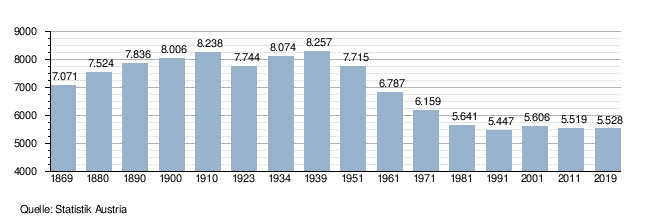
politics
The municipal council has 29 members.
- With the municipal council elections in Lower Austria in 1990, the municipal council had the following distribution: 20 ÖVP, 8 SPÖ and 1 FPÖ.
- With the municipal council elections in Lower Austria in 1995, the municipal council had the following distribution: 20 ÖVP, 7 SPÖ and 2 FPÖ.
- With the municipal council elections in Lower Austria in 2000, the municipal council had the following distribution: 21 ÖVP, 7 SPÖ and 1 FPÖ.
- With the municipal council elections in Lower Austria in 2005 , the municipal council had the following distribution: 22 ÖVP and 7 SPÖ.
- With the municipal elections in Lower Austria in 2010 , the municipal council had the following distribution: 24 ÖVP, 4 SPÖ and 1 FPÖ.
- With the municipal council elections in Lower Austria in 2015 , the municipal council had the following distribution: 22 ÖVP, 5 SPÖ and 2 FPÖ.
- With the municipal council elections in Lower Austria 2020 , the municipal council has the following distribution: 24 ÖVP, 4 SPÖ and 1 FPÖ.
- mayor
- 2000–2011 Karl Wilfing (ÖVP)
- 2011–2014 Gertrude Riegelhofer (ÖVP)
- since 2014 Thomas Grießl (ÖVP)
Culture and sights

- Poysbrunn Palace
- Walterskirchen Castle
- Catholic parish church Poysdorf hl. John the Baptist: The church stands on the Kirchberg in Poysdorf, the early Baroque building was built between 1629 and 1635 and consecrated in 1640.
- Catholic parish church Altruppersdorf hl. Sebastian
- Catholic parish church Erdberg St. Peter and Paul
- Catholic parish church Kleinhadersdorf hl. Rochus
- Catholic parish church Poysbrunn hl. Dorothea
- Catholic parish church Walterskirchen Annunciation
- Catholic parish church Wetzelsdorf Mariä Namen
- The baroque pilgrimage and wedding church Maria Bründl (1740–1751) in Wilhelmsdorf , built by Donato Felice d'Allio
- Vino Versum Poysdorf
- Vintage car museum Poysdorf
- Gstetten Poysdorf , Kellergasse in the shape of a square.
- Vogelsangmühle
- Museums
- Vino Versum Poysdorf : The museum houses one of the richest collections in the Weinviertel and was set up in the former citizens' hospital. In 2012 the museum was closed and renovated and expanded as a location for the Lower Austrian State Exhibition 2013. In 2014 it was reopened as Vino Versum Poysdorf.
- Cellar lane tours are offered every Tuesday and Saturday at Easter and mid-November.
- 1. Austria's Milk Chamber Museum
- Classic car museum
- Night watchman house gallery: The gallery is dedicated to the life's work of the most famous Poysdorf painter Maria Ohmeyer .
- Regular events
- Every year on the second weekend in September, the wine festival takes place, with 30,000 visitors one of the largest wine festivals in Lower Austria.
- Culinary specialties
Poysdorf is called the wine capital and sparkling wine stronghold of Austria. The "Hermannschachern" vineyard was already documented in 1338 and is therefore the oldest documented vineyard in Austria.
The best-known wine is the Grüner Veltliner , which is marketed here as "Poysdorfer Saurüssel" in addition to the Weinviertel DAC .
economy
The sparkling wine production in the Poysdorf wine region is around 25,000,000 liters per year. In 2005, the consumption of sparkling wine throughout Austria was an estimated 20,000,000 bottles.
In addition to viticulture, one of the most important employers is the industrial company Gebauer & Griller , which mainly operates as an automotive supplier and has been running a manufacturing company here since the 1970s. In 2008 the “Golf Club Veltlinerland” was established.
Sports
- 18-hole golf course with driving range, 4-hole public course and hotel
- Weinviertelweg and Jakobsweg Weinviertel
Personalities
- Sons and daughters of the church
- Franz Joseph Müller von Reichenstein (1740–1825), natural scientist
- Franz Seraph Rieder (1806–1873), clergyman, theologian and canon lawyer
- Anton Huber (1818–1874), master builder
- Adolf Schwayer (1858–1922), writer
- Maria Loley (1924–2016), refugee worker
- Karl Wilfing (* 1960 in Wetzelsdorf near Poysdorf), politician ( ÖVP ), resident in Poysdorf
Web links
- 31644 - Poysdorf. Community data, Statistics Austria .
Individual evidence
- ↑ Statistics Austria: Population on January 1st, 2020 by locality (area status on January 1st, 2020) , ( CSV )
- ↑ ZAMG, Climate
- ↑ Heinz Wiesbauer and Manuel Denner: Wetlands - Natural and Cultural History of the Weinviertel Waters , Vienna 2013 (published by the Federal Ministry for Agriculture, Forestry, Environment and Water Management and the Office of the Lower Austrian Provincial Government, Department of Water Management)
- ^ Wolfdieter Hufnagl: The Lower Austrian State Railways. Transpress-Verlag, Stuttgart 2003, ISBN 978-3-613-71214-0 , p. 176
- ^ Army History Museum / Military History Institute (HGM / MHI) , Military History Research Department (MilFoA), study collection, inventory 1945, box 5, fasc. 45/9, municipality reports Lower Austria, District Mistelbach
- ^ Result of the local council election 1995 in Poysdorf. Office of the Lower Austrian State Government, March 30, 2000, accessed on March 20, 2020 .
- ^ Election result of the municipal council election 2000 in Poysdorf. Office of the Lower Austrian State Government, February 4, 2005, accessed on March 20, 2020 .
- ^ Election result of the local council election 2005 in Poysdorf. Office of the Lower Austrian State Government, March 4, 2005, accessed on March 20, 2020 .
- ^ Election result of the municipal council election 2010 in Poysdorf. Office of the Lower Austrian State Government, October 8, 2010, accessed on March 20, 2020 .
- ^ Election result of the 2015 municipal council election in Poysdorf. Office of the Lower Austrian State Government, December 1, 2015, accessed on March 20, 2020 .
- ↑ Results of the municipal council election 2020 in Poysdorf. Office of the Lower Austrian State Government, January 26, 2020, accessed on March 20, 2020 .
- ↑ Werner Kraus: Poysdorf - continue on the way. In: noen.at. May 20, 2014, accessed October 30, 2019 .
- ↑ Pictures from the wine festival in Poysdorf. In: noen.at. September 11, 2012, accessed January 14, 2018 .
- ↑ Hans Stoll: G'schichterl from the Weinviertel - Part 2: The Poysdorfer Saurüssel. In: nachrichten.at. July 24, 2017, accessed February 5, 2019 .


